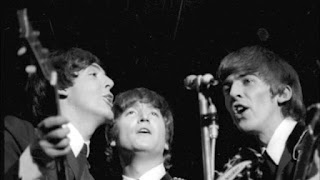On February 15th, 1965, the first song to be recorded for the soundtrack of the group's second feature film was Ticket to Ride. It was also immediately chosen to be the A-side of the next single, released well in advance of the film. While all agreed that it was a terrific recording worthy of being a single, there was also a bit of worry involved, as it was considered to be rather progressive both musically and thematically at the time, and not in keeping with the image of the Beatles as the four lovable moptops. This all seems trivial in retrospect, but it was a legitimate concern in that relatively conservative age - the 60's as we now think of them had not fully blossomed yet.
A good deal of rehearsal preceded the actual takes, with take one breaking down right away, and the complete take two serving as the keeper. Numerous overdubs were then applied, including John double-tracking his lead vocal in places, Ringo adding a tambourine and handclaps, George switching guitars and playing a single note matching the bass line, and Paul playing the quirky lead guitar part that appears intermittently. These overdubs certainly enhance the recording, but the best features remain those on the basic rhythm track - John's aching lead and Paul's soaring harmony vocals, George's towering guitar riff, Ringo's lopsided drum pattern, which Paul had suggested, and, of course, the delightful double time coda.
Before the single was even issued, the boys were in Austria where director Richard Lester shot the brilliant and inventive skiing sequence which would accompany the song in the movie. Once the record was released in April, the band began promoting it on television appearances scheduled on some of their days off from filming, still maintaining the relentless pace demanded by manager Brian Epstein.
The American version of the single on Capitol Records featured a label which stated that the song was from the United Artists release Eight Arms to Hold You, which had, indeed, been the working title of the film for some time. Too late, it was learned that a new title had been chosen, and a new title song recorded within days of this US release.
The boys recorded a fresh version of the song on May 26th for their final BBC Radio special, entitled The Beatles Invite You to Take a Ticket to Ride, as can be heard on the collection Live at the BBC. They then soon set out on a brief European tour in June, with the first stop being Paris. I have a bootleg tape of the first performance, in which they give a spirited rendition of the song at a slightly faster tempo. It was still their most recent release at the time, and the crowd goes wild for it.
On August 1st, they played the song live on the television program Blackpool Night Out, which you can hear on Anthology 2. By this time, they had dropped the second bridge and the repeat of either the first or second verse in concert, shortening the song considerably. This continued to be the case on their North American tour, as you can hear on the 1977 album The Beatles at the Hollywood Bowl.
Naturally, the song appears on both the US and UK versions of the album Help! Though they stopped performing Ticket to Ride after 1965, the song popped up on several compilations over the years, starting with the British release A Collection of Beatles Oldies in late '66. The Red Album from 1973, Reel Music from 1982, and the 2000 worldwide smash 1 all contain the song.
The group's final go at the song took place on November 23rd, 1965. Tired of making television appearances as they had during the filming of Help!, they spent a long day at Twickenham Film Studios shooting videos which could be sent out in their stead to promote several of their recent songs. The one for Ticket to Ride shows the three guitarists sitting and Ringo standing at a partial drum kit in front of a set depicting blown up tickets. John, as was his habit, was unable to mime to the record accurately, so he merely laughs it off whenever he makes a mistake. This video can be found on the collection 1+.


